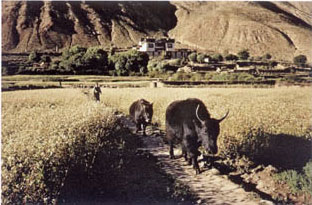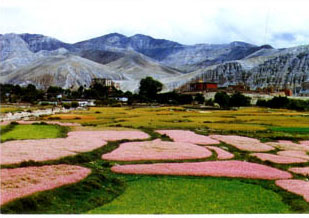TEFF
First grown in 3359 BC (Mengesha 1965) teff today
is primarily raised in Ethiopia, India and Australia (Anon. 1894). While teff
grain still provides over two-thirds of the human nutrition in Ethiopia, it
is rarely consumed elsewhere.
Like other crops grown by early civilizations, teff will grow on marginal soils,
under water. and during droughts (although yields remain low). Ethiopian farmers
first plant maize in April, but if the crop fails,
they plow it under and plant sorghum. If this one
also fails, it is again plowed under and as a last resort they sow
teff, which can be stored for 3 years without losing nutiritional value.
Teff produces food within a relatively short growing season. Upper
class Ethiopians ate the white grain while soldiers and cattle consumed
the reddish-brown.
The bread made from teff is called INJERA. Usually baked injera is a soft,
porous, thin pancake with a sour taste. However long fermentation reduces the
amino acids such as lysine. But if fermentation is shortened sweet injera results,
but it does not remain edible for very long.
Recommended Reading:
Anon. 1894. Tropical fodder grasses. Kew Bul. 95:378-380
Mengesha, M.H. 1965. Chemical composition of Teff (Eragrostis tef) compared
with that of wheat, barley and grain sorghum. Econ. Bot. 19:268-273
Quinoa
[KEEN-wah]
Quinoa has been cultivated in the South American
Andes, since at least 3,000 B.C., making it roughly the same age as teff. Quinoa
thrives in areas where annual rainfall may be as low as four inches, quinoa
is the principal food crop ; high altitudes ( high radiation levels); thin,
cold air; hot sun; subfreezing temperatures; and even poor, sandy, alkaline
soil. The largest producers are the Andean nations Peru, Bolivia, and Ecuador
The seeds are covered with saponin, a bitter resin-like substance that renders
the grain unpalatable to insects and birds. If not removed, the saponin forms
a soapy solution. Traditionally, hand scrubbing in alkaline water or washing
the grain and rubbing in cold water, followed by immediate cooking or sun-drying
removes the saponin. Low-saponin Andean mountain varieties of quinoa cannot
be cultivated in Western Europe because of their daylength sensitivity.
While quinoa is a complete protein containing all eight essential amino acids,
its yields per hectare are relatively low 3-4,000 kilos per hectare or 450 kilos
of protein per hectare. The oil content of quinoa is about 5.6%, which is higher
than that of cereals. It cooks like rice (taking half the time of regular rice)
and expands to four times its original volume. (It also contains 26 mg calcium
per cup).
Quinoa has been added to soups, breakfast foods, pasta, the preparation of
a coarse bread called ‘kispina’ (Weber, 1978), and fermented to make
beer (Simmonds, 1965). Quinoa flour, flakes, tortillas, pancakes, and puffed
grain are commercially available in Bolivia and Peru. Because of its low baking
quality, which is due to the absence of gluten, quinoa flour can only partially
substitute for wheat flour. Replacing up to 10% of the wheat with quinoa is
reportedly succssful.
Quinoa
Recipe
BUCKWHEAT
Buckwheat originated in Central and Western China, most likely in the upper
Yangtse River valley where it hangs in the shelter of boulders on steep slopes
above the river. The Lolo tribe (a recognized non-Chinese 'nationality")
domesticated buckwheat, probably about 3000 B.C., making its cultivation the
same time period as quinoa or teff. They grind the whole grain for flour to
make loaves of heavy bread that are baked in the colas of the fire.
Today Nepal, Northern India, Bhutan and China, particularly in the Himalayan
foothills grow the greatest amount of buckwheat in the world.


Like African teff, and South American quinoa, buckwheat flourishes in poor soils,
especially in shallow mountain soils. It contains water-soluble flavenoid compounds
(rutin) used in the treatment
of hemorrhoids and varicose veins. Removing the hull reduces the rutin content
of the grain by 75%.
Buckwheat even has its own journal FAGOPYRUM (for the scientific name of the
crop Fagopyrum esculentum Moench). It belongs to the same plant family as rhubarb.
While successful in the high mountain soils of the Himalayas for thousands
of years, it only reached Western Europe in the 15th century. It moved north
from China to Siberia, where it survived the short growing season. It then moved
westward across Russia to Eastern Europe.
Blini--small tiny
crepes that you eat with caviar--are traditionally made from buckwheat.
A
Children's Story; A
Song (in Japanese & English) It's not great music, but it is about buckwheat.
Student Taste Test Results

